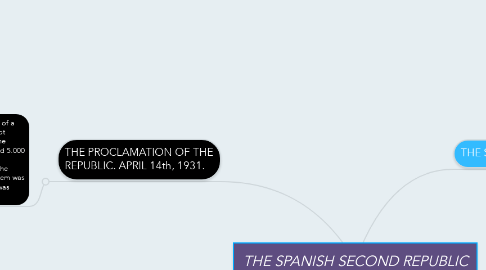
1. THE PROCLAMATION OF THE REPUBLIC. APRIL 14th, 1931.
1.1. The change of regime came by means of a municipal election on April 12th and not through a legal constituent process. The elected republican councilors numbered 5.000 while the Monarchist rose to 20.000. Nevertheless their victory was clear in the urban areas where the caciquismo system was less operative, so the numeric defeat was regarded as a moral victory.
1.1.1. The Republicans saw the weakness of the regime, rejected the offer and required the exile for the King. Alfonso XIII accepted in order to avoid a civil war and thus the monarchy collapsed.
1.1.1.1. On April 14th, 1931 the republican flag was first hoisted in Eibar, then the telephone and the radio spread the news. In the overnight Spain was a Republic after a bloodless coup.
1.1.1.1.1. A provisional government was formed with the parties of the Pact of San Sebastián under Alcalá-Zamora who called a constituent election on June 28th 1931.
2. THE POPULAR FRONT
2.1. D: THE POPULAR FRONT.The electoral campaign was focused on two great options: the left-wing forces joined together around the Popular Front (Glossary 3) and the Right rallied around the CEDA. The Frente Popular won the election with 47,03% of the ballot, while the Right got 46,48%.
2.1.1. Azaña became the President of the Republic and Casares Quiroga was appointed the Head of Government. The reforms of the first biennium were hastened, specially the agrarian reform since the peasants had started to occupy lands. The Right and part of the army saw no way back and prepared a military uprising to restore the order.
3. THE SOCIALIST-REPUBLIC BIENIUM
3.1. The parliament drafted a constitution that was passed on December 9th. Its main problem was a set of contradictions: It tried to reflect every party's opinion instead of agreeing a consensus.
3.1.1. The Military Reform tried to modernize the Army and make it more loyal to the civil power.
3.1.1.1. The Religious Reform tried to separate the Church from the State. The attempt of creating a secular educative system and the removal of the crucifixes from the classrooms was so controversial.
3.1.1.1.1. The Agrarian Reform consisted of the confiscation of the large landholdings (latifundios) and its redistribution among the poor in order to create a more productive rural middle class.
3.2. The government of Azaña failed because of the double attack comming from the revolutionary far left and the reactionary Right in addition to the economic crisis and its own many mistakes.
3.2.1. From the very beginning of the Republic the anarchist practiced insurrectionary tactics in Castilblanco, Arnedo and the Bajo Llobregat in early 1932. It was the fierce repression on an anarchist uprising in Casas Viejas, Cádiz that made the Azaña cabinet fall.
3.2.1.1. The Right-wing CEDA of Gil-Robles accepted the republican regime and the democratic procedures but advocated for a more authoritarian reform of the constitution.
3.2.1.1.1. The monarchist groups, Renovacion Española and Comunión Tradicionalista followed a military coup strategy.
4. THE RADICAL CEDA BIENIUM
4.1. In 1933 the political instability started to become evident. For the conservatives they had gone too far; for the Anarchist and the Unions the reforms were not enough. In the election of 1933 the right-wing CEDA won the election but Alcalá-Zamora appointed Lerroux of the Partido Radical as head of government to appease the Leftists.
4.1.1. The new cabinet paralyzed most of the reforms specially the Agrarian one, and delayed as much as possible the autonomic process.
4.1.1.1. The armed insurrection of the left-wing forces and the unions started to be plotted after their electoral defeat in 1933. The rebellion outbroke in October 1934 mainly in Asturias and Barcelona, using the entrance of the CEDA in the government of Lerroux as a pretext.
4.1.1.1.1. The rebellion was fiercely quelled by the Army by the African troops led by General Franco who defended and saved the regime that month. After October 1934 the political positions both of the Right and the Left radicalized.

